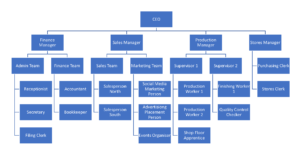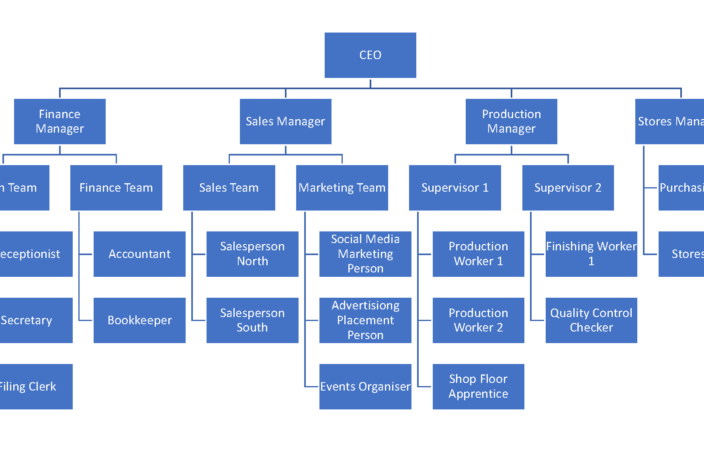Put All Your Employees In Their Places!
You need to put your staff in their place!
No, I don’t mean be a strict disciplinarian and shout at everyone!
That’s not the way to build stability and loyalty – and let’s face it – not the way to build a long-term business!
No, what I mean is that like any group of people, like any team, each person needs to have a role to play.
In order for your team to be productive and effective, everyone knows where they fit into the system, how they work with others, and how they are to be measured in their work.
Small businesses grow organically, so it is not unheard of to find that in small businesses, some of your employees are jack of all trades.
There’s nothing wrong in that, but trust me, in order to grow and scale, you need to identify where everyone sits in the team and what their primary purpose is.
Here’s the disaster that could happen, so read on:
You start your business on your own, or maybe with a partner or a spouse.
It’s exciting at first and you do everything, from opening the doors and switching on the lights in the morning, to greeting customers and answering the phone, to making the product and sending it out, to making the tea and then to close the store in the evening.
If there are two of you, often you switch things around, and both of you do everything and help out when the other is busy.
As you succeed, you get busy.
Where once it was exciting to print the sales invoices, it starts to get a bit busy so you do them a bit later in the day. So you hire someone to take some of the load, and because you’re so small you get them to do a bit of everything as well.
The three of you work well at first.
You’ve got no time to do the books? Your partner will do it today.
The store looks a bit untidy but you have to go see a customer? Don’t worry your new employee has some time, she’ll tidy the store.
But you get busier, and one day the mix-ups start to happen and something gets missed.
“I thought you were going to do that?”
“Sorry, I was busy with this, I thought you were going to do it?”
This is how a small business grows. As you get busy, you need a system to ensure people are doing what needs to be done.
The best way to do that is to create your organisation chart so that everyone can see at a glance what their roles and responsibilities are.
You can remain flexible, and as a happy team, of course, people can help out – but everyone knows that their primary purpose is and what tasks they are responsible for so that these are not missed.
Here is what an organisation chart can do for your business.
It allows you to plan ahead for growth.
If you designed your organisation chart into the future, you can anticipate potential numbers and roles from your vision of how you want to grow. This gets you ready to commit resources and ensure that people are in place to service the customers you seek in new markets and industries.
Looking at the future organisation chart, you and your employees can see what kind of a future workers will have in your business – where their career paths may lie as they learn and develop new skills to move up the chart, or even across to different functions.
An organisation chart organises how work is done.
You can organise different processes in your business and draw your chart to reflect this.
If you do this, you can clearly identify how each part of your process fits in with another so that your teams can work together efficiently.
Looking at your organisation chart, anyone can see what you actually do in the business, for example, what services or products you sell, and whether you develop these yourself or purchase them in, and how you organise the back-end of your business from deliveries to support to administration.
An organisation chart helps induction.
For the reason described above, having an organisation chart makes it easy to induct a new employee and tell him or her what they do, who they hand off to, who supervises them or who they are responsible for. Coupled with some systems and procedures, they will fit in faster and more efficiently.
New inductees get to learn new names and titles more quickly and better understand how they fit in the business.
An organisation chart defines the important tasks and who is responsible for them.
Using an organisation chart clarifies who is ultimately responsible to get tasks done. This will avoid those times when people thought someone else was doing them, as well as those times when people waste time doing something that someone else has done.
Outlining these responsibilities in a chart means that people can find who they need to speak to in the business if they want something done.
An organisation chart helps promote employee goodwill and growth.
Having a clear understanding of how they fit now, and what opportunities are available for them as they learn and develop experience is an important benefit of organisation charts for employees.
They know what they are expected to do, they can see their promotion opportunities, they can even identify the skills and experience they need to progress.
What is an organisation chart?
To put it simply, an organisation chart is a picture of how your business is organised and shows the inter-relationship between areas of responsibility or function, and the reporting relationship of individuals.
Here is an example of one –

The example shows the business has the functions of finance, sales, production and stores.
In each of these functions, headed by a manager, are various teams or individuals, and the chart shows who are actually in those teams.
From this alone, you can see who does what. Their titles tell the story of what they do and what they are responsible for. In reality, organisation charts are usually accompanied by each employee’s Job Description which details their primary purpose or role in the business along with the responsibilities of that role, and their reporting relationships.
If you worked for this business, you can see from this chart what your responsibilities are, who you reported to, and who you could rely on for help.
How do you record your organisation chart?
My first piece of advice is to start now, recording not what your business looks like now, but what you want it to look like at some foreseeable time in the future.
Design a “complete” organisation chart, even if you don’t have the employees yet, or even if one or two individuals wear all the hats at the moment!
The reason you do this is to build in the planning aspect, and identify the skills and experience you will need at this time in the future, and allow yourself to find the resources to populate the chart.
The present form of this “complete” chart may include a lot of boxes that are either “unfilled at this time” or mat indeed show the names of the one or two individuals who are doing everything at the moment. In fact, this helps because you can see who may have too much responsibility and work and therefore identify priority hires.
This also helps because as new hires are brought in, the person currently showing in that box can show them the ropes and hand over that part of their multip[le responsibilities in an efficient and planned fashion.
Start by identifying the functions, departments or natural task-teams in the business.
The next step is an imaginative one. Because you may not have all the employees you need right now for this organisation of the future, you need to decide on the titles you will give the managers in charge of those functions, departments or task teams.
Put the titles of the manager in charge in separate boxes under you as the boss-in-chief. It’s the first row of boxes in the above diagram below “CEO”.
Then imagine what sub-sections or sub-teams may operate under each manager and draw the boxes of those sub-teams under the manager – in the diagram above, this is the third row.
Then, under each sub-team put boxes to represent the individual workers that will be part of those sub-teams.
If you already have some workers, it’s important here to put them out of your mind and design a structure for the future, where they may not be there. So, don’t think of existing names and what they do or can do, think of position titles and what each position should do.
Once you have an organisation structure with positions rather than personalities, you can test this by writing down a short description of what each position does. When you are eventually happy with the way you have portrayed every position, then, and only then should you “populate” this structure with existing names.
Remember, in your current situation, some of those boxes may not have a person’s name in them because your business has to grow to a certain extent to require that position.
Also remember that in your current situation, some people may appear in more than one box, because at the moment there is a bit of “everyone does everything.”
The point is that this allows you to plan ahead – from the people who are there now, who are overtasked and replacements should be found for some of their “extra” duties?
Where are there obvious gaps that you need to recruit right now? Are people doing the right things commensurate with their skill and experience, and perhaps some should move? Where can people who are there now grow and move up to?
The next thing to do is to expand on your initial short description of what each position does.
For each position, write a Position Description.
When you do this, once again, think of the position, not of the person who fills that position now, so that you describe the ideal set of responsibilities, not what the incumbent is good at.
A Position Description should contain:-
- An objective – what is the primary purpose for this position in the business? What is the outcome that the position should achieve?
- A set of responsibilities – what that position does, and what that position is ultimately responsible for.
- Reporting Structure – Who that position reports to, and what positions report to them?
- If necessary, detail the set of skills or experiences required, and where this is not clear from the responsibilities, you may add a list of tasks they will perform.
Once you have completed that, you can discuss the structure with existing staff, make changes to responsibilities, reposition people where necessary, and ensure they understand their stated objectives and responsibilities.
Having a forward-looking organisation chart allows you to:-
- Plan ahead for recruitment at the appropriate time
- Align staffing resources with your business plans
- Ensure everyone knows what they are there to achieve and what they are responsible for
- Delegate responsibilities and be happy that they’ll be done right
- Review your employees to see if they are doing the right jobs for their skills and personalities and identify weaknesses in the structure
- Encourage teamwork where people are doing their individual jobs that connect together for the group’s advancement
- Discuss career-paths with the right-minded employees
Go and try it out!
And if you haven’t already, go to teikoh.com and sign up to get more of these tips and tools to grow your business delivered directly to you!







No comments yet.
Add your comment